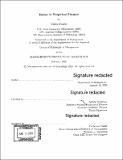| dc.contributor.advisor | Adrien Verdelhan. | en_US |
| dc.contributor.author | Fourel, Valère(Valère Renaud Ernst) | en_US |
| dc.contributor.other | Sloan School of Management. | en_US |
| dc.date.accessioned | 2020-10-19T00:42:57Z | |
| dc.date.available | 2020-10-19T00:42:57Z | |
| dc.date.copyright | 2020 | en_US |
| dc.date.issued | 2020 | en_US |
| dc.identifier.uri | https://hdl.handle.net/1721.1/128096 | |
| dc.description | Thesis: Ph. D., Massachusetts Institute of Technology, Sloan School of Management, 2020 | en_US |
| dc.description | Cataloged from PDF version of thesis. | en_US |
| dc.description | Includes bibliographical references (pages 157-165). | en_US |
| dc.description.abstract | Considering that monetary policy is multi-dimensional and cannot be solely reduced to changes in the short-term interest rate, Chapter 1 revisits the bank lending channel literature. Our approach consists in finding whether there are some significant cross-sectional disparities in the way French banks that exhibit different bank characteristics respond to various types of monetary policy shocks. We first extract from changes in interest rates around ECB's monetary policy announcements four different types of monetary policy shocks. The Target factor affects mostly the very-short end of the yield curve, the Timing factor, the 6-month interest rate and the Forward Guidance, interest rates at the 5-year horizon. The Quantitative Easing factor essentially moves interest rates at longer maturities. We then combine these monetary policy shocks that we first aggregate at the monthly frequency with our sample of monthly data on French banks for the period 2007 to 2018. | en_US |
| dc.description.abstract | We uncover three new facts: 1) bank's size matters for monetary policy transmission when we consider a Forward Guidance shock; 2) Liquid assets held by a bank can be a vector of the smooth transmission of monetary policy; 3) Banks with a high share of deposits on their liability side tend to reduce their lending to non-financial corporations after an expansionary Timing or a Forward Guidance shock. Using a loan-level dataset, our results are robust when controlling for any firm-specific demand shock. In the second chapter which is a joint work with D. Rime, L. Sarno, M. Schmeling and A. Verdelhan, we build the largest dataset of high-frequency exchange rates so far: our sample covers the spot prices and order flows of 19 currency pairs over the last 15 years measured on the two main trading platforms at the 30-second frequency. | en_US |
| dc.description.abstract | We uncover four new facts on intraday exchange rates: 1) The carry and dollar risk factors explain a large share of the intraday exchange rate variations; their explanatory power increase from 30-second to daily frequencies, while the explanatory power of order flows is more limited and decreases from 30-second to daily frequencies; 2) Dollar and carry betas are very persistent: their autocorrelation coefficients are around 0.5 at the daily horizon and 0.7 at the weekly horizon, thus offering a new key characteristic of exchange rates; 3) Dollar betas are correlated to bond yields; and 4) they are caused by additional trading. In the third chapter, exploiting a high frequency dealer-specific quote database of the FX market, we show that shocks to the CDS of a financial intermediary, proxy for its financial wealth, makes her quote larger bid-ask spreads when uncertainty about the underlying traded asset is high or when market competition is low. | en_US |
| dc.description.abstract | We first establish that markets are dominated by a handful of dealers who are responsible for more than 90% of the quotes in the different FX spot markets. We then document that, when exchange rate volatility is high, a 1% increase in intermediary's default probability does translate into a 4 bps increase in the bid-ask spread that she quotes. When competition is low, a similar deterioration in financial wealth leads to a 6.4 bps increase in bid-ask spread size. We finally show that in the case of emerging country currencies, the average CDS spread of the financial intermediaries quoting in the FX market is a statistically significant predictor for the volatility of the idiosyncratic component of the currency risk premium. | en_US |
| dc.description.statementofresponsibility | by Valère Fourel. | en_US |
| dc.format.extent | 165 pages | en_US |
| dc.language.iso | eng | en_US |
| dc.publisher | Massachusetts Institute of Technology | en_US |
| dc.rights | MIT theses may be protected by copyright. Please reuse MIT thesis content according to the MIT Libraries Permissions Policy, which is available through the URL provided. | en_US |
| dc.rights.uri | http://dspace.mit.edu/handle/1721.1/7582 | en_US |
| dc.subject | Sloan School of Management. | en_US |
| dc.title | Essays in empirical finance | en_US |
| dc.type | Thesis | en_US |
| dc.description.degree | Ph. D. | en_US |
| dc.contributor.department | Sloan School of Management | en_US |
| dc.identifier.oclc | 1200233476 | en_US |
| dc.description.collection | Ph.D. Massachusetts Institute of Technology, Sloan School of Management | en_US |
| dspace.imported | 2020-10-19T00:42:56Z | en_US |
| mit.thesis.degree | Doctoral | en_US |
| mit.thesis.department | Sloan | en_US |
